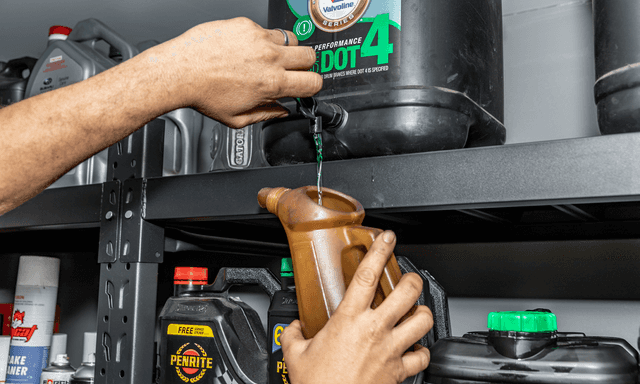- clutch
Signs & Symptoms of Low Clutch Fluid

Updated 20 Oct 2023
Jason Unrau

Having problems with your clutch?
It might seem like it’s too soon for your clutch disc to need replacement even though the symptoms might seem to fit.
But did you know that low clutch fluid can often be the root cause of the issue?
In fact, if your car’s clutch fluid is low, it can lead to additional damage and repairs.
That’s why it’s important not to delay – find out why your car’s clutch isn’t working like it used to.
Here are some common signs and symptoms of low clutch fluid and what you should do about it.
Spongy clutch pedal
When you press the clutch pedal down, does it feel smooth and consistently springy throughout its travel? It should.
If your clutch pedal feels soft or ‘spongy’ at any point as you press it to the floor, it’s a sign your clutch fluid is low.
That spongy, inconsistent feeling is due to air in the clutch line from the master cylinder to the slave cylinder.
It compresses at a different rate than clutch fluid, giving you that erratic feeling in the pedal.
The air will need to be bled out of the clutch system and the fluid topped up to correct the condition.
Resistance in gearshift lever
Is it hard to push the gearshift lever into the next gear while you’re shifting?
You’ll hear people say, “It’s the synchros,” but it’s usually just low clutch fluid.
When the clutch fluid is too low, it doesn’t create enough hydraulic pressure to move the slave cylinder completely.
The clutch isn’t disengaging fully from the flywheel, making it more difficult to find the next gear.
Top up the clutch fluid – there’s a good chance the symptoms will go away!
Lurching when shifting gears
Shift your manual transmission up or down.
When you ease off the clutch, does it lurch and jerk about?
You might also notice the clutch doesn’t disengage until the pedal is nearly on the floor.
It’s easy to blame this symptom on an almost burnt-out clutch, but it could just be low clutch fluid.
Just like resistance in the gearshift lever, it’s due to less clutch fluid flowing through the hydraulic line.
It’s not able to create full movement, giving you very little travel to work with.
Top the clutch fluid up and expect to feel a difference.
Grinding gears
When the clutch fluid becomes very low, you can notice shifting becomes almost impossible.
Even the most experienced manual transmission drivers can be heard grinding gears then.
It’s at this point that pressing the clutch pedal barely moves the slave cylinder and the clutch remains somewhat engaged with the flywheel.
Driving like this can cause clutch disc damage as it drags against the flywheel.
It adds unnecessary wear and tear and inadvertently adds cost to your repair.
How to top up clutch fluid
It’s extremely easy to top up clutch fluid.
Simply locate the reservoir near the engine bay, remove the cap, and add new, clean fluid from a sealed container.
Always match the clutch fluid with the requirements in your owner’s manual.
But go one step further. Is there a reason the clutch fluid is low?
Have the clutch system inspected by a qualified mechanic on AutoGuru to determine if there is a leak or seepage, and have it repaired in short order.

Written By
Jason Unrau
Jason is a Canadian automotive content writer with a background in the auto service industry, but he’s been hooked on cars and mechanics since childhood.
One of his first cars was an ’80 Mazda RX-7 that’s sorely missed to this day. A ’68 Ford Torino GT, a ’66 Ford Country Squire Woodie station wagon, and a ’96 Suzuki GSX-R 750 have spent time in his fleet of cars, bikes, and trucks over the past two decades.
Jason’s pride and joy is under construction – a turbocharged ’88 Mazda RX-7 convertible. Also on his resume is CASCAR official certification.